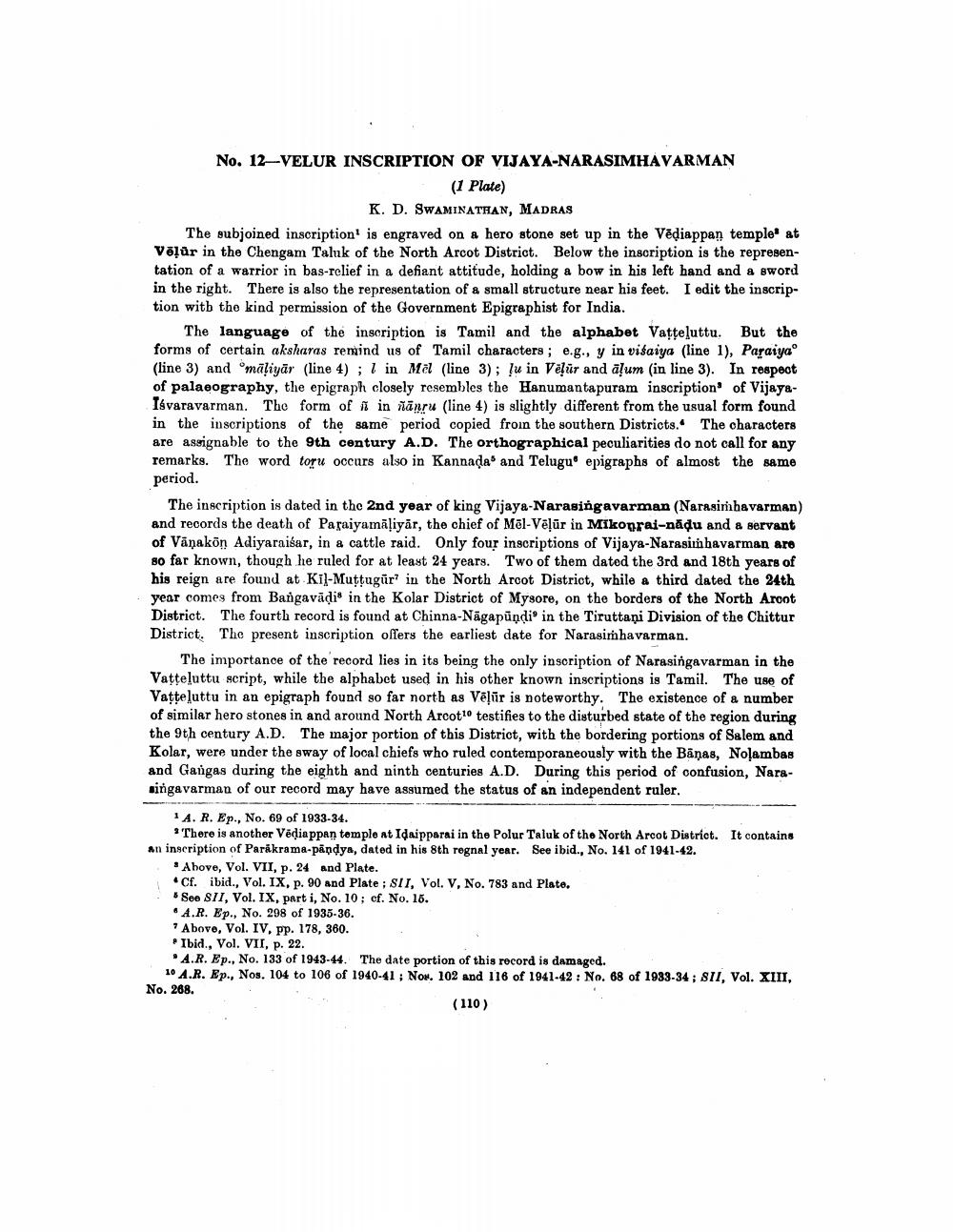________________
No. 12–VELUR INSCRIPTION OF VIJAYA-NARASIMHAVARMAN
(1 Plate)
K. D. SWAMINATHAN, MADRAS The subjoined inscription is engraved on a hero stone set up in the Vediappan temple at Vēļūr in the Chengam Taluk of the North Arcot District. Below the inscription is the representation of a warrior in bas-relief in a defiant attitude, holding a bow in his left hand and a sword in the right. There is also the representation of a small structure near his feet. I edit the inscription witb the kind permission of the Government Epigraphist for India.
The language of the inscription is Tamil and the alphabet Vatteluttu. But the forms of certain aksharas remind us of Tamil characters; e.g., y in visaiya (line 1), Paraiyao (line 3) and māliyār (line 4); 1 in Mel (line 3); ļu in Vēļür and āļum (in line 3). In respect of palaeography, the epigraph closely resembles the Hanumantapuram inscription of VijayaIsvaravarman. The form of it in sānru (line 4) is slightly different from the usual form found in the inscriptions of the same period copied froin the southern Districts. The characters are assignable to the 9th century A.D. The orthographical peculiarities do not call for any remarks. The word toru occurs also in Kannada and Telugu epigraphs of almost the same period.
The inscription is dated in the 2nd year of king Vijaya-Narasingavarman (Narasimhavarman) and records the death of Paraiyamāļiyar, the chief of Mēl-Vēļūr in Mikoprai-nadu and a servant of Vāņakon Adiyaraisar, in & cattle raid. Only four inscriptions of Vijaya-Narasimhavarman are 80 far known, though he ruled for at least 24 years. Two of them dated the 3rd and 18th years of his reign are found at Kil-Muttugūr? in the North Arcot District, while a third dated the 24th year comes from Bangavādi* in the Kolar District of Mysore, on the borders of the North Aroot District. The fourth record is found at Chinna-Nāgapūņdio in the Tiruttani Division of the Chittur District. The present inscription offers the earliest date for Narasimhavarman.
The importance of the record lies in its being the only inscription of Narasingavarman in the Vatteluttu script, while the alphabet used in his other known inscriptions is Tamil. The use of Vatteluttu in an epigraph found so far north as Vēļūr is noteworthy. The existence of a number of similar hero stones in and around North Arcotto testifies to the disturbed state of the region during the 9th century A.D. The major portion of this District, with the bordering portions of Salem and Kolar, were under the way of local chiefs who ruled contemporaneously with the Bānas, Noļambas and Gangas during the eighth and ninth centuries A.D. During this period of confusion, Narasingavarman of our record may have assumed the status of an independent ruler.
14. R. Ep., No. 69 of 1933-34.
* There is another Védiappan temple at Idaipparai in the Polur Taluk of the North Arcot District. It contains an inscription of Parikrama-pandya, dated in his 8th regnal year. See ibid., No. 141 of 1941-42.
*Above, Vol. VII, p. 24 and Plate.
Cf. ibid., Vol. IX, p. 90 and Plate ; SII, Vol. V, No. 783 and Plate. * Soe SII, Vol. IX, part i, No. 10; cf. No. 15. . A.R. Ep., No. 298 of 1935-36. Above, Vol. IV. pp. 178, 360.
Ibid., Vol. VII, p. 22. .A.R. Ep., No. 133 of 1943-44. The date portion of this record is damaged.
10 A.R. Ep. Nos, 104 to 106 of 1940-41 : Now. 102 and 116 of 1941-42 : No. 68 of 1933-34 ; SII, Vol. XI, No. 268.
(110)




